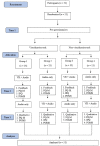Exploring the Use of Virtual Reality for the Delivery and Practice of Stress-Management Exercises
- PMID: 34149524
- PMCID: PMC8209249
- DOI: 10.3389/fpsyg.2021.640341
Exploring the Use of Virtual Reality for the Delivery and Practice of Stress-Management Exercises
Erratum in
-
Corrigendum: Exploring the Use of Virtual Reality for the Delivery and Practice of Stress-Management Exercises.Front Psychol. 2021 Sep 8;12:752647. doi: 10.3389/fpsyg.2021.752647. eCollection 2021. Front Psychol. 2021. PMID: 34566826 Free PMC article.
Abstract
Background: Mindfulness-based interventions may benefit healthcare professionals with burnout symptoms. Virtual reality (VR) may reduce initial difficulty of engaging in mindfulness exercises and increase participants' engagement through immersion and presence.
Aim: The aim was to investigate how VR affects participants' experience of engagement with mindfulness practice, and its impact on quality of practice and negative mood states.
Methods: Fifty-one healthcare professionals were randomized to receive either a visualization or non-visualization mindfulness practice, to compare the quality of practice through the use of audio only vs. with a virtual reality interface. Selected self-reported measures were collected during the session (immersion, quality and difficulty of practice, mood states and likelihood for future practice).
Results: Results showed that order instead of type of modality administered made a difference in quality of mindfulness practice. A greater sense of presence was reported with VR if administered after audio (F = 4.810, p = 0.033, Partial η2 = 0.093). Further, participants described difficulty practicing with audio if administered after VR (F = 4.136, p = 0.048, Partial η2 = 0.081). Additionally, lower mood disturbance was reported with VR if administered after audio (F = 8.116, p = 0.006, Partial η2 = 0.147). Qualitative responses echoed a preference for VR to engage better, in addition to improved mood states after practice.
Conclusion: Findings suggest that VR has the potential to provide healthcare professionals with an alternative or a supplement to conventional mindfulness practice.
Keywords: burnout; healthcare professionals; mindfulness; mood; virtual reality.
Copyright © 2021 Soh, Ong, Fan, Seah, Henderson and Doshi.
Conflict of interest statement
The authors declare that the research was conducted in the absence of any commercial or financial relationships that could be construed as a potential conflict of interest.
Figures
References
-
- Bailenson J. N., Aharoni E., Beall A., Guadagno R., Dimov A., Blascovich J. (2004). “Comparing behavioral and self-report measures of embodied agents social presence in immersive virtual environments,” in Paper Presented at the 7th Annual International Workshop on Presence. (Spain: Stanford University; ).
-
- Barsade S. G. (2002). The ripple effect: emotional contagion and its influence on group behavior. Adm. Sci. Q. 47 644–675. 10.2307/3094912 - DOI
-
- Biocca F., Levy M. (1995). Communication in the Age of Virtual Reality. Hillsdale: Lawrence Erlbaum Associates.
LinkOut - more resources
Full Text Sources



